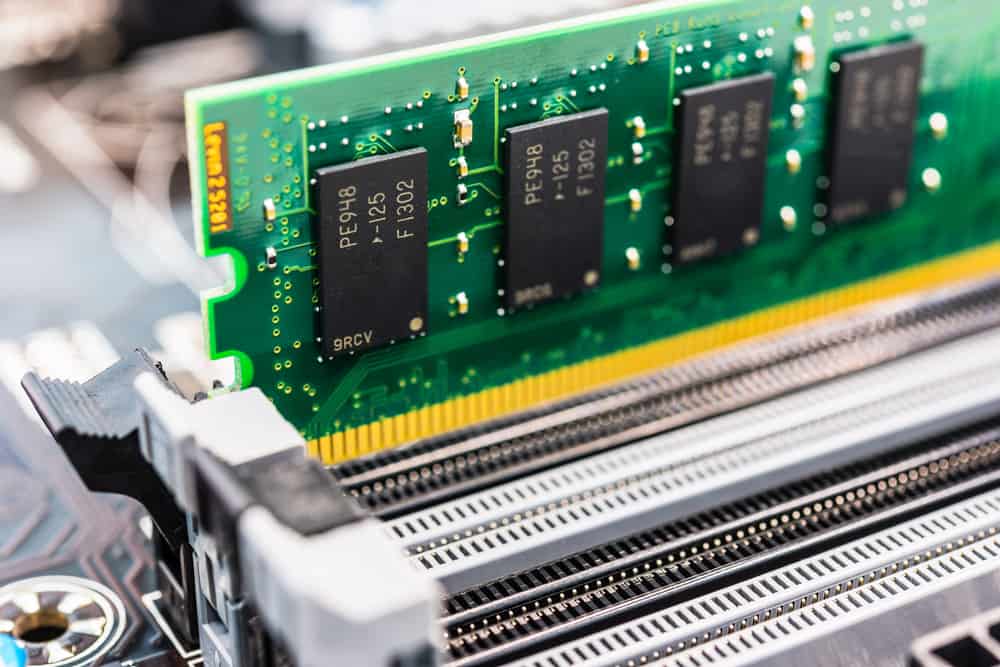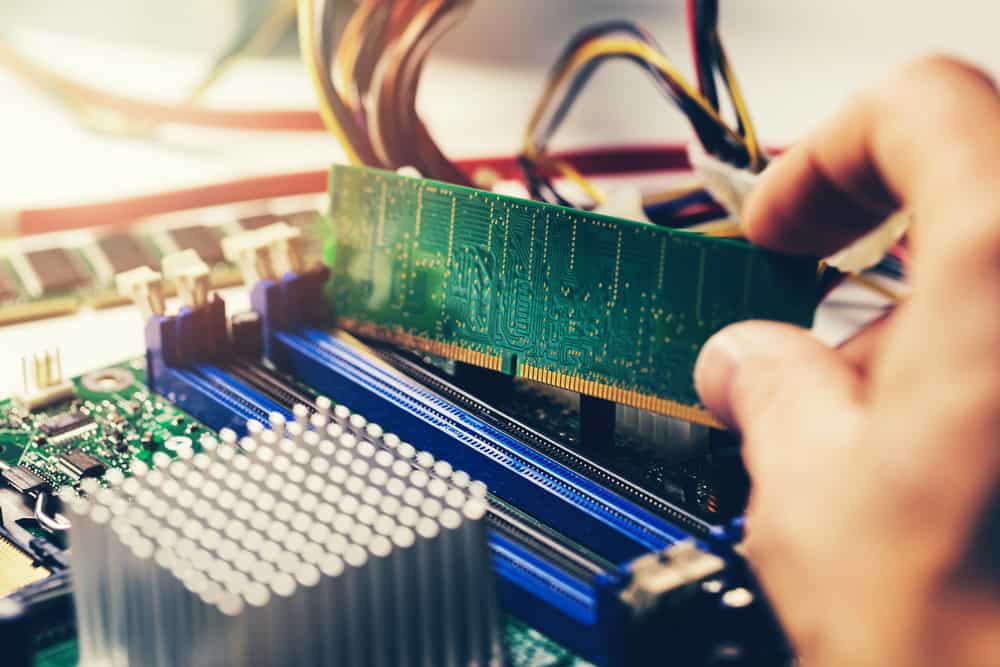
Random Access Memory sticks or memory modules are basic PC components that can remember data and computations for a certain amount of time.
They can store temporary information that the CPU needs to perform its calculations.
It’s usually better to have more RAM if you want to speed up your computer.
However simple its job may be, a debate arises whenever someone is looking to upgrade their existing memory or buy a new RAM kit: Can I use two different brands of RAM?
When you talk about different brands, other factors come into play like RAM types, sizes, voltages, speeds, latencies, and so on.
You’ll have to consider all these factors to ensure your computer operates using the best possible memory performance.
Read on to learn about basic RAM specifications first, and then find out if you can mix different RAM brands, types, sizes, speeds, and so on.
Can I Use 2 Different Brands Of RAM?

Yes, you can mix RAM brands.
Can you expect high performance from your system afterward?
Most professionals recommend that you use RAM sticks from the same brand, and there are three main reasons for this.
The first reason isn’t solely related to the brand itself.
It’s about the fact that when you get different RAM brands, other specs will usually be different, too.
It isn’t the brand that affects the output of two RAM sticks, but its speed, voltage, latency, size, and other vital features.
We’ll discuss the importance of these factors being the same with RAM modules in the following sections.
Of course, you can try to find different RAM brands with the same specs or spend time tweaking them with dedicated software, but there’s no guarantee that it’ll work for you.
The second reason concerns the RAM’s quality.
Even if you find two RAM brands with matching specs, the material they’ve used to build the RAMs might be different, resulting in different qualities.
Your system will always end up performing to the abilities of the lower quality RAM.
The third and most serious reason is that you may face technical issues like power usage or power cycling problems.
Different RAM brands might even cause issues with memory retention at startup and shutdown or during regular use.
Although it’s not common, the Blue Screen of Death error is also possible with such a setup.
These problems are more likely to happen to avid gamers or those who use their computers heavily in general.
If you’re only going to do light tasks like surfing the web, you might not even notice any issues with different RAM brands.
However, at the end of the day, it’ll be a lot of work to achieve something that might not pay off in the end.
To ensure that everything plays well together and keep your system working at its best possible level, go with the same RAM brand for all the sticks.
Can You Mix Different RAM Types?

The answer to this question is a strict “No.”
You can’t and shouldn’t mix different RAM types.
Every motherboard is built to fit and process one generation of DRAMs, and you can’t even place a different type of RAM into the board since all five generations have a different placement of pins.
Therefore, it’s not possible to fit one DDR2 and one DDR3 RAM stick into your motherboard.
They must be the same type.
You should find out which RAM type your motherboard supports before purchasing one.
In Windows 10, open Task Manager, head to the Performance tab and choose Memory to see the DDR type.
If it wasn’t there, install and run software that gives you information about your PC components, like CPU-Z.
Can You Mix Different RAM Sizes?

It’s a common misconception that you can’t pair two different RAM sizes in your system.
It’s possible to use two or more different RAM sizes, but it has a downside.
Same-sized RAM sticks are programmed to work together in a state called flex mode or dual-channel mode whenever possible to reach the best performance.
That’s why manufacturers make and sell RAM sticks in 2x4GB or 2x8GB kits to pair two identical and compatible RAMs.
If you pair a larger storage capacity with a smaller storage unit, the lower capacity RAM will be paired with half of the larger storage.
For example, if you mix a 4GB RAM stick with an 8GB RAM stick, they’ll perform like two 4GB RAM modules in the dual-channel mode for the best performance.
Once both sticks are filled up to 4GB, the remaining 4GB in the second RAM will run in single-channel mode.
You may experience some slowing in this state, depending on your situation.
If you use your PC for undemanding workloads, you won’t notice the difference between the single and dual-channel modes.
However, when playing heavy games, doing 3D rendering, simulations, video editing, and similar intensive works, dual-channel bandwidths can boost the performance up to 20%.
The only factor that can minimize the performance loss to an extent is if you match the voltage, speed, and latency of the two different-sized RAM sticks.
Read the following sections to find out more about these factors.
Can You Mix Different RAM Voltages?

Different voltage requirements that two RAM sticks may have won’t prevent you from combining them, but it won’t create an optimal situation.
Two different RAM brands with different voltages will cause the motherboard to run with the lowest one by default, resulting in the more power-demanding RAM stick getting less voltage than necessary.
This issue won’t keep the RAM from operating, but it’ll prevent it from functioning at its full potential with its peak frequency and stability.
Can You Mix Different RAM Speeds?

It’s not uncommon to mix RAM kits with different speeds, but you should know that a chain can only be as strong as its weakest link.
When you combine two RAM sticks with different frequencies, you should expect your motherboard and the memory controller to underclock the faster RAM, configuring the kits to run at the speed of the slowest module.
They’ll likely work just fine, and you won’t notice any issues, but you’ll feel the lack of performance when you’re doing intensive tasks like gaming.
You might be able to overclock the weaker RAM sticks, but you’ll risk overheating and lagging issues.
The above scenario is for when you’re lucky enough to get the RAMs working.
You probably will run into errors with such a setup, like BSOD errors and frequent crashes.
The risk will be higher if you pair older RAM models with new ones.
Can You Mix Different CAS Latency And Timings?

The story is the same for latency and timing.
It’s possible to mix two RAM sticks with different latencies, but your system will automatically force the one with the faster timing to work at the lowest level, which may cause performance issues.
If you know your way around the BIOS settings, you might be able to get RAMs with varied latencies and frequencies to work smoothly together, but it’ll take a lot of time and effort, and it’ll still be a coin toss.
Why Is It Better To Buy Your Total RAM Capacity In A Single Kit?
RAM models that you find up for sale within the same package, also known as RAM kits, have been factory-tested to work flawlessly with each other but not with other brands and models.
Each manufacturer can develop its RAM modules differently.
They may use different materials, custom circuits, RAM controllers, PCBs, and so on.
These customizations can raise conflicts in some cases if you pair two different RAM brands.
The more RAM slots you want to fill in your computer, the higher the risk of incompatibility.
Moreover, as mentioned previously, different RAM features like size, speed, voltage, and so on can bring multiple downsides to the table.
Here are the disadvantages of mixing RAM:
- No dual-channel performance benefits with different RAM sizes.
- Lower speed since the system downclocks to the lowest speed.
- Lower latency since the system matches the lowest latency.
- Compatibility issues with each other or the motherboard.
- Stability issues in your system.
- Crashes, errors, or stuttering happening randomly.
- Failure to boot the system entirely or getting the Blue Screen of Death.
If you don’t want to go through all this trouble and risk your computer’s health, you need to plan your upgrades depending on your workloads.
This way, when you want to increase RAM size or speed, you can simply buy more identical RAM sticks and avoid possible issues.
Understanding RAM Specifications

To fully understand the answer to the big question about mixing RAMs, you need to know what specifications and features define a RAM.
If you’re already a pro in this area, skip this section and go straight to the answer.
1. Memory Form Factor
RAM modules are available in two primary and standard form factors:
- Dual In-Line Memory Module or DIMM: The DIMM is the RAM form factor used for desktop computers, and it refers to the physical size of the RAM stick, which is bigger for desktops. The standard length is 133.35 mm for DIMMs.
- Small Outline DIMM or SO-DIMM: SO-DIMM RAM modules are for laptops and compact computers in general. They’re almost half as small as DIMMs, at just 67.6 mm in length.
2. Memory Type Or Generation
As technology has evolved over the years, RAM sticks have also improved and gained more enhanced features and capabilities.
There are five main generations for the DDR SDRAMs (Double Data Rate Synchronous Dynamic RAM) that are commonly in use today:
- 2000 release: DDR1 SDRAM
- 2003 release: DDR2 SDRAM
- 2007 release: DDR3 SDRAM
- 2014 release: DDR4 SDRAM
- 2020 release: DDR5 SDRAM
There’s no backward or forward compatibility between these RAM generations, and you can’t fit one into a slot made for the other since they use a different number of pins.
3. Memory Size
RAM sizes refer to the capacity of each RAM stick and how much information it can store.
RAM modules come in different sizes, varying from 2GB to 32GB.
For instance, you can get two 4GB RAM sticks, so your computer has a total of 8 GB memory space.
4. Memory Speed
RAM speed or frequency is the number of cycles a RAM stick can perform every second.
The higher the RAM frequency, the more data your RAM can read and store, and the smoother your system will work.
RAM frequency is measured in megahertz (MHz), million cycles per second.
For example, if you see the number 3600MHz next to a RAM’s name, you’ll know that it can perform 3.6 billion cycles per second.
That means the RAM stick can transfer that many bits in one second!
5. Memory Latency
Latency is the amount of time it takes a memory module to respond to a call or command your system gives by accessing a specific set of data in one of its columns.
You’ll see the letters “CL” next to a number in a RAM’s specifications, indicating its latency.
For instance, a CL16 RAM stick will take 16 cycles to respond to a command.
The lower the latency, the faster your RAM will be.
6. Memory Voltage
The power that the DRAM modules consume is referred to as their voltage.
Different RAM types and models have different voltages ranging from 1 V to 1.4 V.
You can make your RAM run at different voltages to adjust performance and stability, but it’s not recommended to overclock it more than 1.5 V.
7. Memory Brand
Different manufacturers or assemblers are making RAM sticks and putting them up for purchase, and each has a different brand name.
It’s a known fact that two different manufacturers can make the same RAM sticks and sell them in slightly different packaging.
However, you can never be sure since they never publicize all RAM specs or retailers.
You could find two RAM modules with the same type, size, frequency, latency, and voltage, but the memory and controller chips could end up being different.
Frequently Asked Questions About RAMs

1. How Many RAM Slots Does A Motherboard Have?
Most modern motherboards support four slots or two dual-channel slots.
However, the maximum supported RAM may differ.
For instance, one motherboard may support up to 4x 8GB sticks, while another can handle 4x 16GB sticks.
High-end servers may come with more slots, often supporting up to 128 GB of RAM, which isn’t unusual for intensive computations.
Finally, supercomputers are designed to have dozens of slots and support multiple terabytes of temporary memory.
2. How Do I Know How Many RAM Sticks I Have?
Although opening up your computer may seem like the easiest way to count the number of sticks, you don’t actually have to do any physical work or risk damaging your computer.
Almost all operating systems come with a tool or setting to tell you about your RAM configuration.
On Windows 10, press the Windows key and type in Task Manager.
Alternatively, you can press Ctrl + Shift + Esc.
Once you’re in the Task Manager, go to the Performance tab and then Memory.
You can see the number of slots on your motherboard, and how many of them are being used.
If you’re on a Mac, go to About This Mac and click on More Information.
The screen will give you a basic graphical representation of the number of available slots and how they’re occupied.
Finally, for Linux users, you can use a command-line tool (like almost everything else in Linux!).
Fire up your terminal by pressing Ctrl + Alt + T, type sudo dmidecode -t 17, and hit enter.
If you’re prompted to enter your admin password, type it in and hit enter again.
The command will give you a list of your physical cards as well as a host of other useful information about each stick’s characteristics.
3. Can I Use All RAM Slots On My Motherboard?
The ultimate answer depends on your motherboard, but it’s almost always better to have an even number of identical sticks.
If your motherboard comes with four slots, preferably leave two of them empty.
If you need a large amount of RAM, use all four as leaving one slot empty can cause performance issues.
NEXT: Will A Laptop Hard Drive Work On A Desktop? (Everything To Know)



























Thanks. This is a great concise and informative article for those of us who are new to the world of pc building and upgrading.
That’s a great article .
Thank you
A great explanation, Thanks
This was the most clean text I’ve ever read about RAMs. Thanks